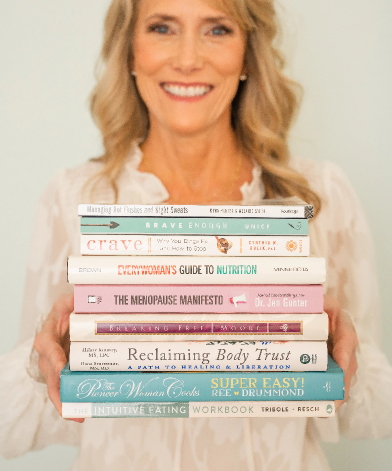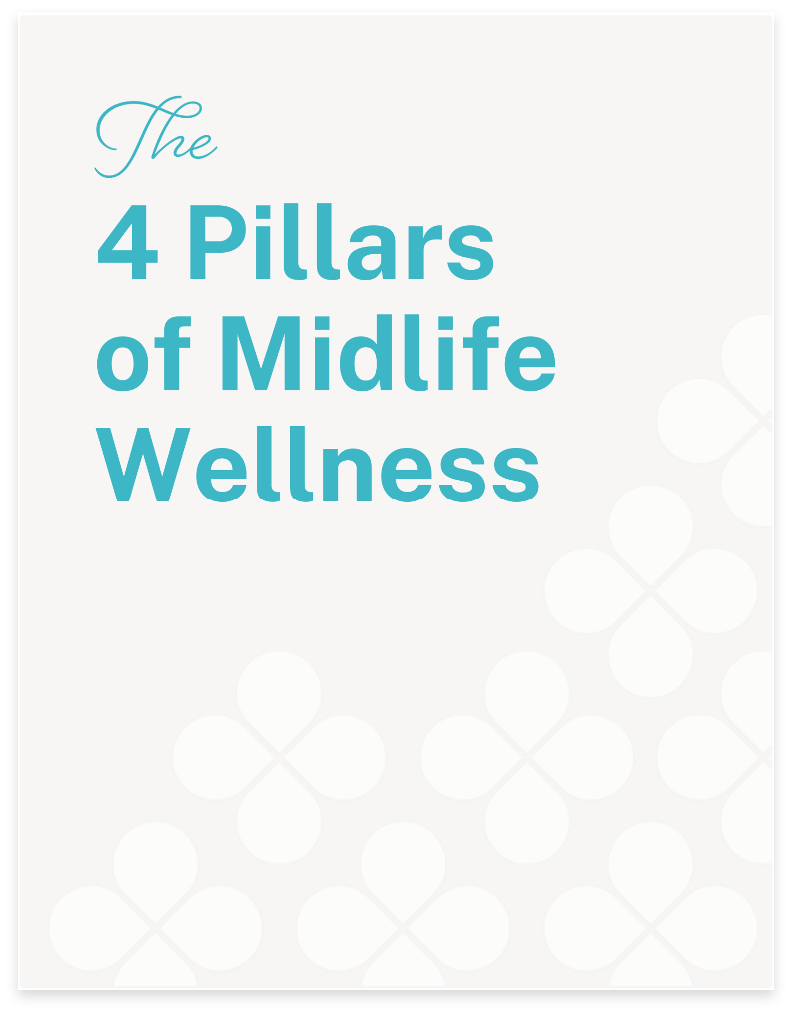Clarity = Confidence
With increased clarity about the impact of nutrition on your health and aging process, you can gain more confidence in making everyday choices about what to eat and how to care for yourself.
SIGNATURE PROGRAM
Get Ready to Feel Your Best with My
Midlife Health Assessment
My approach to health and wellness is sensible, safe, and science-based. I will help you focus on discovering a lifestyle approach that works for you, and together we will create an action plan to get you started on your journey to optimal health and longevity.

- Your story
- Health and nutrition concerns
- Goals
- Exercise history
- Medical history and blood work
- Any disordered eating concerns
- Your questions
- Overall health status
- Heart health
- Bone health
- Digestive health
- Supplement intake
- An increased sense of control over your health and wellbeing
- Reduced anxiety and stress related to health concerns and aging
- Improved confidence in your ability to make informed health and lifestyle choices
- Increased motivation and accountability for making positive changes
- Improved overall mood and emotional wellbeing
You’ll receive a post-assessment summary with ample resources to get you started. Consider this the owner’s manual to your midlife health!
FINALLY UNDERSTAND WHAT YOUR BODY NEEDS TO THRIVE
Let’s connect!
I offer a free 20-minute discovery call to determine the best service to support your midlife journey. Schedule a call or request my service and rates information below.
Together, we can get you the answers you need.
As a menopausal woman with an eating disorder, Val has been a lifeline in my recovery as she possesses immense wisdom and supports me with compassion, respect and great care.
— Midlife client with an eating disorder
SUPPORT GROUPS
Hot Topics: More Ways To Learn
Val offers two unique group programs to support women during menopause and beyond.

Hot Topics in Menopause, Midlife, and Beyond
Join Val for a live Zoom meeting each month when she will share her expertise on all things menopause. This 20-30 minute talk will be followed by 15–20 minutes of Q&A with attendees. During the meeting, Val will answer frequently asked questions about menopause and attendees are welcome to ask anything they’d like. Once a month, attendees will receive a newsletter highlighting the hot topics from the previous month’s meeting.

The REAL You: Embracing Your Body in Midlife & Beyond
For those who have decided to stop dieting but still struggle with body dissatisfaction, Val offers a therapeutic group program focused on body image, mindful self-care, and managing menopausal symptoms, such as hot flashes. In this group, Val will help participants learn what to do with negative thoughts about their body and experience less anxiety about their appearance, weight-related concerns, and menopause. This group offers a supportive community for women to improve their relationship with their bodies and feel confident in their own skin.
R
Resilience
Menopause and midlife can bring unexpected challenges, but developing resilience can help women navigate these changes with greater ease and strength.
E
Empowerment
As women move through midlife and menopause, they have the opportunity to empower themselves with knowledge, self-care practices, and support from others.
A
Acceptance
Accepting the changes that come with midlife and menopause can help women find peace and contentment in this new chapter of their lives.
L
Longevity
By prioritizing their health and wellness during menopause and midlife, women can increase their chances of living a long and fulfilling life.
Join one or both of Val’s group programs to receive valuable support, education, and connection during your health and wellness journey.
Frequently asked questions…
No, my services are self pay only. I am an out-of-network provider for insurance and can provide you with a “super bill” that you can submit to your insurance provider for possible reimbursement, depending on your policy and coverage for nutrition services.
Yes! In fact, if you do not have a team that includes a therapist or psychologist who specializes in eating disorders, along with a physician (and possibly a psychiatrist) who is following your medical care, I will help you find a team.
I have experience with all ages and genders. At this time, I am working with individuals age 25 and up.
My philosophy aligns with the principles of Health at Every Size®. As such, my approach is focused on sustainable, health-enhancing behavior change that discourages restrictive eating, dieting and excessive activity. Health, mindful self-care, and body acceptance (not body size) are outcomes that I focus on with my clients.
No. According to the American Academy of Allergy, Asthma & Immunology, these tests have never been scientifically proven and are not recommended as they mislead consumers. For those concerned about food allergies, I recommend finding a board-certified allergist.
No, I do not offer hormone testing, but I am happy to collaborate with your gynecologist, primary care physician or endocrinologist and review any blood work or testing you may have done by licensed and qualified providers. My role is to help you understand your body and guide you with making informed choices about nutrition and lifestyle behaviors that can help you improve your overall well-being.
That entirely depends on the purpose of our meeting, your goals, your readiness to change, what support systems you have in place and many other factors. We can discuss timing and what to expect at your initial appointment.
All my offerings are virtual and can be accessed in all 50 states. Certain services I offer require licensing, which I have in Georgia, Minnesota, and Alabama. Don’t hesitate to get in touch with me, and I will advise you on how I can help you.

After asking many nutritionists for another diet, I found Val. I lived obsessed with losing weight, feeling like a failure but unable to do another diet. Val validated my feelings yet challenged my perspective. I now understand that I’m not a food addict; that my brain is helping me survive through hunger, and that I eat well (including cake) and exercise to live a full life. I’ve learned there’s no magic weight loss formula (especially in menopause), that my body is normal, and fine as is. I’d still love to lose weight but refuse to stop living until I do.
— Midlife client wrestling with dieting

I Am Here To Help You Embrace Your Midlife And Beyond
After completing the Midlife Health Assessment, clients often want continued support as they work toward their health goals. I have a variety of options to choose from based on the level of support you’re interested in. Want to be sure this is the right approach for you or discuss questions prior to scheduling your assessment? No problem. Contact us and we’ll be happy to help.

